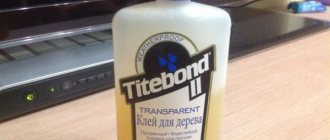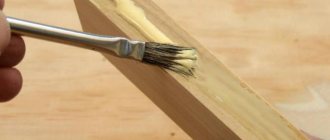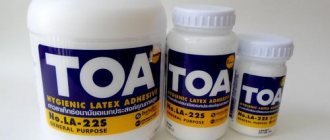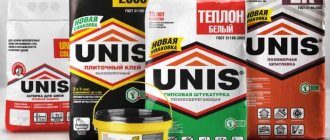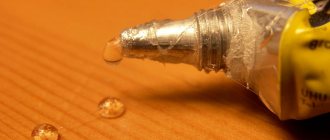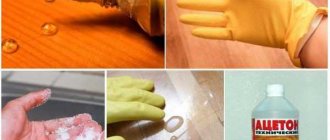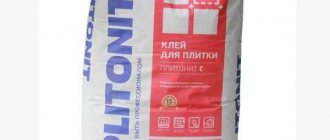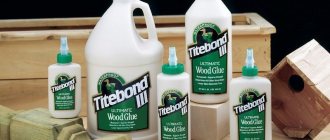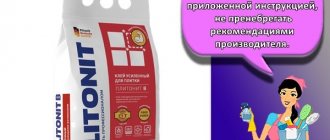Varieties
This adhesive composition has several varieties, each of which has its own characteristics and properties:
- Titebond 2 is the most moisture-resistant and strong type of glue in this line; it cannot be removed even with a solvent. When frozen, it can come into contact with food and will not cause any damage to health (when used in kitchen furniture and household appliances).
- Titebond 3 – has relatively low strength and can also come into contact with food without causing harm.
- Original Titebond is a special type, practically no different from the previous ones in composition and application. Its main advantage is the ability to be used for repairing musical instruments, since it does not spoil the sound of wooden products.
- Titebond Heavy Duty is an ultra-strong construction adhesive that can withstand metal objects, brick, and fiberglass. You can also highlight its resistance to moisture.
Types of glue
There are more than 25 types of titebond wood glue, but one-component products for universal use with water-repellent properties are more common. The declared properties will manifest themselves in full if the working surface is carefully prepared and the instructions for the composition are followed. After such work, the water-repellent properties of the seam are guaranteed.
Kinds:
- Titebond Heavy Duty is an ultra-strong adhesive in a yellow tube, capable of firmly connecting concrete, brick, and ceramic substrates. It is made on the basis of synthetic rubber, which provides high adhesion. The resulting seam is flexible, which prevents it from breaking under vibration loads.
It is permissible to work with damp, frozen wood.
- Titebond liquid nails are widely used in construction for professional use. Work with the product is carried out inside and outside the building.
- Titebond III wood glue comes in green packaging. The mass has special strength and water resistance. It is acceptable to use for gluing objects in contact with food, since the composition does not contain toxic compounds. Gluing can be done using hot or cold methods. Polymerization occurs 20 minutes after connecting the elements.
- Titebond II Premium has a blue container, one-component composition. It is resistant to moisture and sets quickly. Most often used when connecting parts of furniture. The composition contains no toxic compounds.
Glue characteristics
Despite the possibility of professional use, the products in the series do not require special skills or knowledge during application
They are easy to use; you just need to read the instructions carefully. A regular tool, including a metal one, is suitable for the job; the glue does not stick to the metal, and all devices can be easily cleaned
The main property that distinguishes Titebond adhesives from PVA and liquid nails is their high moisture resistance, which meets American standards.
Other properties and technical parameters of Titebond adhesives:
- All adhesives become transparent after hardening, despite the initial dullness of the consistency. They can be applied even to delicate items.
- The products are frost-resistant; after drying, the seam will withstand temperatures down to -35 degrees. Also, glued bases can be heated to +40 degrees, but at +100 the seam area can catch fire.
- The strength of the glue joint will be very high, much higher than the wood itself. This determines the durability of the glued products. The seam is resistant not only to water, but also to the influence of solvents and acoustic vibrations.
- Adhesives are universal, they are suitable for all types of wood, as well as other wood-based compounds, combined materials, and many types of plastic. You can also effectively fasten paper and cardboard with these products. Elastic compounds are suitable for use as sealants.
- All errors in work - stains, drips - can be washed off with water before complete hardening. This is very convenient for adjusting the adhesive seam.
- Polymerization of the composition is quick (10-20 minutes), but still not instantaneous, and it is quite possible to correct the position of the parts. As humidity increases and temperature decreases, polymerization may slow down. You cannot work with the composition at temperatures below +10-12 degrees.
- There is no need to subject the parts to strong compression or installation under a press. They will stick together even with a moderate degree of fixation, adhesion will not decrease.
The most popular adhesives of the Titebond brand have a dry residue of 48%, their viscosity is 4000 mPa/s, and their acidity is 3 pH. Material consumption is 180 g/sq.m. see. After opening, each product remains suitable for use for a long time (up to 2 years) if stored at a temperature of about +20 degrees. It is not advisable to apply the composition to painted substrates; use it in rooms with too high humidity or poor ventilation.
Main advantages
Titebond is a super-strong glue that adheres to surfaces almost instantly (10-20 minutes). When gluing parts, pressing is only necessary for a short period of time. In this case, serious compression or placement under the press is not required - fixation with medium effort is sufficient.
See also
The best way to seal a car's iron gas tank, do-it-yourself repair tools and rules
Used ready-made, without requiring dilution. Economical to use, consumption depends on environmental conditions. Has a world-class certificate.
The adhesive joint has increased strength and is not afraid of sudden changes in temperature and humidity, which guarantees the durability of the glued materials.
Tightbond adhesives are suitable for all types of wood, many types of plastic, as well as other mixed compositions based on wooden materials. Before the glue dries, all stains and drips formed during the work process are washed off with water.
Instructions for use
You can start working with the product only at positive temperatures indoors or outside buildings. For all types of adhesive compositions, preliminary surface preparation is very important: in the presence of dust, sawdust, and other contaminants, the degree of adhesion may decrease. In addition to such contaminants, grease, oil stains, and old paint should also be removed. For this purpose, the following methods are used:
- grinding with a special machine, sandpaper;
- using a scraper;
- washing with household or professional detergents;
- wiping with degreasers and solvents.
Work only in a well-ventilated area. Due to the environmental friendliness of the composition, it is possible not to use special respiratory protection, but for allergy sufferers, people with hypersensitivity and lung diseases, masks (respirators) are required. If you feel dizzy, you should immediately leave work and go out into the fresh air. If glue gets on the skin, it must be washed thoroughly with soap, otherwise there is a risk of irritation and redness. When the product gets into the eyes, rinse them well (at least 10 minutes), and if necessary, consult a doctor.
Titebond glue is one of the highest quality and convenient products that do not need to be diluted, but can be used in finished form. It has the highest moisture resistance among similar compounds and is economical, which is why it is most often used by professionals.
How to use it correctly
Working with Titebond glue does not require special skills or knowledge. When using it, the main thing is to strictly follow the instructions. Work should be carried out only at positive temperatures.
See also
Technical characteristics of Perlfix mounting adhesive, instructions for use and consumption
Surface preparation
The surface of materials prepared for gluing must be dried and cleaned of dust, grease, oils and other contaminants using solvents. It is not recommended to apply Titebond to painted surfaces, so old paint should also be removed.
Working with glue
Mix the glue thoroughly, apply it to the surface of both parts with a brush and squeeze them well, avoiding moving. During the drying period (10-20 minutes), remove excess with a damp cloth. If necessary, change the position of the parts before the glue dries.
Precautionary measures
It is necessary to work in ventilated areas using protective equipment (especially for allergy sufferers). If the adhesive gets on the mucous membrane of the eyes, it is necessary to rinse the eyes with running water for a quarter of an hour. If dizziness or nausea occurs, quickly go outside. In case of contact with skin, quickly remove and wash with soap and water.
Keep out of reach of children.
Types and scope of application of glue
Titebond wood adhesives are high quality woodworking compounds for professional and home use. They have different bases depending on the specific purpose: artificial rubber, polyurethane, aliphatic resins. The products also contain polymers, protein compounds, water, various modifiers and plasticizers.
In total, there are 25 types of adhesives in the Tightbond line, but the most common on the domestic and European markets are universal one-component products with strong water-repellent properties. Their technical characteristics are unique: if the base is properly prepared and the instructions are followed, the adhesive joint will be practically unaffected by moisture. Most adhesives can be used for the following purposes:
- laying parquet boards at home, in offices;
- restoration of old wooden coverings;
- Furniture assembly;
- gluing wooden and plastic parts;
- production of plywood products;
- various repair work.
Depending on the specific type of waterproof glue, its properties and purpose may vary. The main types of Titebond adhesive compositions:
- Original Wood Glue. Adhesive with a red label is used for repair, restoration of musical instruments, and in the production of similar products. After drying, it forms a hard, low-plastic joint that does not interfere with the normal sound and does not change the properties of the wood.
- Titebond II Premium. This product has a blue sticker, it is also moisture resistant, and is not susceptible to solvents. The adhesive seam will be quite elastic, the initial setting will be more powerful. Due to its environmental friendliness, the glue can be used for gluing wooden cutting boards and other products in indirect contact with food. Also, glue number 2 is used for repairing indoor, garden, and other outdoor furniture, mailboxes, veneer products, laminate, plywood, fiberboard, chipboard. It is packaged in bottles, jars, buckets and even barrels with a volume of 0.037-100 liters.
- Titebond III Ultimate. Tightbond 3 glue with a green sticker is water-based, has an opaque consistency, and a cream color. All polymers in the composition are harmless to health, so the product is well suited for products that come into contact with food. Most often, glue is used in the food industry, but it can also be used for repairs and restoration of plywood, veneer, other types of wooden surfaces, as well as plastic. It is suitable for outdoor and indoor use, but is not suitable for products placed in water.
- Titebond Heavy. This is a super-strong assembly adhesive, available in a yellow tube. It contains artificial rubber, due to which it does not harm any type of wood, and can even be used for gluing wet, frozen wood. The finished adhesive seam is elastic, not subject to destruction, flexible, and does not deteriorate from mechanical stress. In addition to wood, this glue is suitable for gluing ceramics, slate, organic glass, natural and artificial stone, fiberglass, concrete, and ceramic parts.
Composition and properties
Depending on its purpose, the adhesive from the Taitobond line is based on polyurethane, artificial rubber or aliphatic resins. Additives include a certain amount of various plasticizers, modifiers, and in addition to them, protein compounds and water.
The glue is not abrasive, which means it does not damage the tools used for subsequent processing and finishing of products. After drying it is transparent and does not distort the appearance of the material. Resistant to freezing, heat (up to +40 C), and solvents. Burns at +100 C. Cannot be used on wet surfaces.
After opening it is stored for 2 years.
Characteristics of Titebond II Premium Wood Glue
Titebond glue, which you can distinguish by the designation II Premium Wood Glue, is sold in blue packaging and is a moisture-resistant composition that meets stringent American standards for water resistance. It is used for gluing hard and soft wood. In carpentry, you can make surface and butt joints, as well as glue paper film, laminate, veneer, chipboard, MDF, fiberboard and plywood.
This composition is used in furniture production, providing the most durable setting even with short pressing times. You will be able to obtain greater bonding strength, which is even higher compared to the wood itself.
Titebond brand review
It is known that Franklin International is a leader in the production of quality wood products. For more than 70 years, it has been practicing in the development and production of adhesives. It achieved its leadership due to the quality of its products, while the price is not too high.
Since 1935, the company has been producing Titebond glue, produced on various bases. The product is tested and meets ANSI/HPVA Type II, Type I (USA) standards. More than 25 types of adhesives are produced for industrial use.
The entire range of the company is adapted to the Russian market. It is constantly growing and improving.
Instructions for use
- Preparation of material for gluing: the material must be prepared for gluing on the same day. Maintain the correct level of bonded surfaces. Surfaces must be cleaned of wood dust. To achieve uniform pressure distribution during gluing, the difference in thickness of the material to be bonded should not exceed ± 0.15 mm. Maximum deviation scale of the material to be bonded: 1.5 mm.
- Application: The application amount of glue is usually 120-150 g/m2. In the case of porous materials or uneven surfaces, the above value may be increased.
- Gluing time: 7-10 min. The setting time depends on the amount of glue applied, the porosity of the material to be glued, the moisture content of the wood, the gluing temperature, etc.
- Pressing pressure: Pressing pressure mainly depends on the type of laminated wood. Suggested values: for soft wood species: 7.0-10.5 kg/cm2;
- medium hard: 8.8-12.3 kg/cm2;
- solid: 12.3-17.6 kg/cm2.
_
Features and Benefits
- High water resistance;
- Low application temperature;
- Excellent connection strength;
- Easy to clean when wet.
- For outdoor use;
- Perfectly processed, does not affect finishing coatings;
- Ideal for use in cold, hot and HF presses;
- Load group according to EN 204/205 1K/D3.
- Meets ANSI Type II water resistance requirements;
- Dries quickly;
- Easy to apply;
- It has a white color, when applied, its excess is clearly visible;
- Dried glue is resistant to water and solvents
How to remove?
Since liquid nails are a difficult glue, the impurities in the composition make it very difficult to remove from almost any surface.
If the liquid nails have not yet dried, then this composition can be removed quite easily with a rag and water - this applies to hard objects. If these are clothes or upholstered furniture, then you need to resort to using a solvent. If the glue has already hardened, it will be much more difficult to do this. In most cases, the packaging of high-quality glue contains instructions for removing this composition. If there is no such instruction, then you can resort to the following tips.
To remove the glue, you need to prepare the following items:
- water with solvent;
- liquid nail cleaners, which will be needed for the final removal of residues, are sold in special construction stores;
- latex gloves;
- scraper, knife or flat screwdriver;
- a piece of fishing line or wire.
When all the components are ready, you should start cleaning:
- first you need to slightly lift the piece of dried glue with a scraper or other flat object;
- then you need to insert a wire or fishing line under this piece;
- after this, with the wire inserted, you need to remove the main part of the glue using cutting movements;
- Remaining stains can simply be removed with water or a special cleaner.
Liquid nail gun
Liquid nails are usually packaged in special tubes. To make working with them easier, a liquid nail gun is designed. It consists of the following parts:
- holding device;
- trigger mechanism;
- a disk that applies pressure to the inside of the tube;
- stock;
- a tongue that acts as a latch.
To work with the gun, you need to prepare a tube of liquid nails directly. To do this, it is opened and the tip is screwed on. In order to insert the tube into the gun, remove the tongue from the locking position and pull the rod towards you until it stops. Then we place the tube in the gun, and move the rod away from us until the disc fully stops. It should rest against the squeezing mechanism in the tube. Then, by pressing the trigger, we set in motion the squeezing mechanism in the tube. Due to this, the glue comes out of the tube.
In order to stop the flow of glue, you need to release the locking tab and pull the rod towards you.
Main characteristics
Liquid nails at the moment of installation are quite strong and reliable glue. It is several times stronger than other species. It prevents oxidation of the material, thereby eliminating corrosion and the appearance of fungus.
Types of liquid nails
Depending on the area of application and composition, liquid nails are divided into the following types:
- Liquid nails containing a water base. In other words - glue on acrylic. They are usually used in low humidity conditions. Cannot be used at low temperatures. Designed for fastening objects that have a porous structure. Very often used for tiles, PVC, mirrors. These include super-strong adhesive MVP-70, which is a durable material that is designed for gluing a wide range of materials. MVP-70 contains polyacrylate. It contains no solvent and therefore no odor. MVP-70 has a transparent base, so it is ideal for attaching glass and mirrors. The gripping force reaches up to 70 kg/m2.
- Liquid nails containing an organic solvent. They are easy to distinguish from acrylic ones; they have a pungent odor. When working with them, it is necessary to take care of safety, since frequent use is harmful to health. But the result of the work is pleasing. With their help you can mount almost any material of significant weight.
Advantages
Due to the high efficiency of liquid nails, they have a number of advantages over other adhesives:
- Gluing objects made of plastic, wood, metal and ceramics is very simple and without any problems.
- The drying process does not occur instantly, but rather quickly and provides high strength. Due to the fact that the glue does not dry instantly, it is possible to correct shortcomings made during installation.
- Liquid nails do not destroy the structure of the material, which helps prevent the formation of corrosion.
- They have frost resistance, low flammability and resistance to vibration processes.
It is the possession of all the listed characteristics and advantages that explains many positive reviews about liquid nails.
Precautions during operation
Some types of Titebond liquid nails contain substances that emit an unpleasant odor; for this reason, the technician must wear a respirator. You need to choose high-quality tools for work so that they are safe, because gluing is often done on objects that come into contact with food. Protective gloves and clothing should be worn.
Some types of Titebond liquid nails contain substances that emit an unpleasant odor; for this reason, the technician must wear a respirator.
Titebond liquid nails are distinguished by creating reliable adhesion to different materials. Some types require special operating technology; if you follow the instructions, you can get a long-lasting result. The choice of product is made taking into account the characteristics of the item and the influences that will be exerted when it is used after repair.
Tips for use
In order for the work to proceed with a favorable result, you should use tips for using titebond wood glue:
- It is better to apply the mass at positive temperatures.
- It is recommended to dry the base thoroughly and remove any dirt or grease deposits.
- If the product has been standing for a long time, it is recommended to thoroughly mix the composition before use.
- The mass polymerizes in 20 minutes, so work is carried out quickly; correction of defects is allowed within the first 5–10 minutes.
- To ensure full adhesion, the product can be installed under a press.
- If the working surfaces have a paint layer applied, it is recommended to first remove it or sand it.
- The work is carried out in protective products, which will help protect the skin from pollution.
- The work is carried out in a well-ventilated area where the humidity is set within normal limits.
- Expired mass is not used, since the declared properties are not fully ensured.
Useful video on the topic:
Tips for use
Titebond is recommended to be used only at above-zero temperatures. The substrates to be bonded must be dry, thoroughly cleaned of dirt, grease and foreign particles.
Before applying the substance to the surface, it must be stirred. It should be remembered that the composition completely hardens in 10-20 minutes. Therefore, it must be prepared before starting work. To ensure a tighter adhesion of the surface, you can hold it under pressure for some time.
The adhesive mixture is not recommended for joining painted surfaces or on wet surfaces.
All work with glue must be done in protective equipment. For this, special gloves and glasses are used. If the product gets on the skin or mucous membranes, it should be washed off with plenty of water, and if necessary, consult a specialist. The room should be well ventilated. Air humidity should not exceed established standards.
The shelf life of the waterproof adhesive is 2 years from the moment the package is opened. It should be stored at room temperature. It is not recommended to use expired glue.
Among those who have used the adhesive composition in everyday life, there are both positive and negative opinions.
Positive aspects include ease of use, high density of surface adhesion, and rapid hardening. There are reviews that the strength of the glue is higher than the strength of the wood itself. It is noted that the substance can be easily removed from any surface before it dries.
Disadvantages include the inability of the adhesive to maintain its structure in direct sunlight. Rapid destruction of the adhesive seam is noted. You can also find reviews that the glue dissolves in water, so it is not recommended for repairing boats. Many note the rather high cost.
When using the formulations as intended and following the instructions for use, there are no complaints about the product. Negative reviews are most often associated with violations of application technology or the use of low-quality compounds
It is important to note that any repair products should be purchased in stores. In this case, you must carefully study the instructions, and if you have any questions, consult with a specialist
You will find useful tips on gluing wood in the following video.
Peculiarities
This type of glue is endowed with the following qualities:
- the strength of the hardened glue is much higher than that of the wooden part itself, which indicates high reliability;
- versatility - can be suitable for wood of any type and age, as well as various plastic parts;
- does not stick to auxiliary tools that are used to remove excess glue;
- tolerates fairly low and high temperatures;
- it sets quickly, but before it dries completely it can be easily cleaned with water, which allows you to correct any unevenness or inaccuracies;
- can only be used in interior decoration of a room - this glue is not suitable for the outdoor side;
- Titebond should be applied to a dry surface that is well cleaned of various debris;
- long shelf life.
The composition of this glue includes water-based resins, so it has a viscous consistency that hardens over time. Titebond brand glue is a very practical and fairly versatile means for joining parts.
Features of use
Before gluing wood to another substrate, you must first prepare both surfaces. To do this, they are cleaned of debris, dust or residue of other substances. Then the glue needs to be shaken or mixed in the bottle and applied to the base with a convenient brush.
Then fasten both surfaces.
It will take the technician 10 minutes to correct their position or remove excess glue.
Note! If glue accidentally gets on the skin, it is enough to remove the dirt with simple clean and slightly warm water.
Titebond wood glue increases the efficiency, quality and speed of any work, including repair, decorative, and production.
Application and properties of Titebond glue (2 videos)
Types and uses of Tightbond adhesives (15 photos)
Varieties
There are about 25 adhesives from the Titebond line that are widely used in industry. The following four one-component compositions are considered the most popular in our country.
Original Wood Glue
It goes on sale in containers with a red sticker. Suitable for restoration, repair, production of musical instruments. When dried, it does not change its woody qualities, does not distort the sound, and becomes hard. In addition, it can be used for assembling furniture.
Specifications:
- viscosity – 3200 mPa*s;
- dry residue – 46%;
- acidity – 4.6 pH;
- minimum temperature of use - +10 C;
Not recommended for outdoor use.
Titebond 2 Premium
Has a blue label. Suitable for gluing all types of wooden products. Suitable for gluing joints and joints. Allows you to work with laminate, chipboard, fiberboard, veneer, plywood and paper film. Good for restoring furniture and gluing various boards. It has excellent adhesion with a short pressing period.
Physical properties of the glue:
- viscosity - 4000 mPa*s;
- dry residue - 48%;
- acidity - 3 pH;
- minimum temperature of use - +12 C;
- consumption per 1 m2 – 180 g.
This type of glue is resistant to heat, solvents and acoustic vibrations. After using this glue, the products will not come apart at temperatures from -30 to 50C. The dried composition has a creamy transparent tone.
Titebond 3 Ultimate
Water-dispersed adhesive sold in containers with a green label. The consistency is creamy and opaque in appearance. Prepared on the basis of water. Intended for fiberboard, chipboard, veneer, plywood, MDS, wood and plastic. Suitable for indoor and outdoor use. It has particularly good moisture resistance.
Titebond 3 Ultimate is non-toxic. Can be used for things used to store food, as well as those that directly interact with food products.
The adhesive composition can be used using a hot or cold method. In the first case, the speed of the surface setting process is increased by heating the adhesive joint or the wood itself.
Composition properties:
- viscosity – 4200 mPa*s;
- dry residue – 52%;
- acidity – 2.5 pH;
- density – 1.1 kg/l;
- consumption per 1 m2 – 190 g;
- drying time – 10-20 minutes;
- The minimum temperature of use is +8 C.
Heavy duty
Super strong assembly adhesive, sold in a yellow tube. It contains artificial rubber, which allows you to glue wet, frozen wooden products. The adhesive seam does not change due to physical impact, is not destroyed, and is not susceptible to the formation of fungus.
In addition to wooden surfaces, it allows gluing slate, ceramics, organic glass, fiberglass, artificial and natural stone. Suitable for use in interior and exterior decoration of buildings, installation of floor coverings, repair and production of garden equipment, creation of decorative elements, installation of mirrors.
Properties:
- viscosity – 150 Pa*s;
- dry residue – 65%;
- density – 1.1 kg/l;
Titebond Heavy Duty super strong adhesive (yellow tube)
| Product DescriptionUniversal construction adhesive Titebond Heavy Duty
Designed for gluing wet frozen treated wood, metal, brick, concrete, subfloors, panels and plywood. Application areaTitebond universal construction adhesive is the strongest adhesive of this type, excellently glues wet, frozen wood, lumber, metals, brick, concrete, stones, plywood, hardboard, dry plaster, chipboard, panels, slate, ceramics, fiberglass, etc. Professional builders prefer this adhesive for its exceptional strength, long-term durability and flexibility. The adhesive meets all the requirements of the American Plywood Association specification AFG-01 and other relevant US organizations and is certified by the State Committee for Sanitary and Epidemiological Surveillance of the Russian Federation. Physical propertiesThe basis: synthetic rubber; Directions for use
Security measuresUse only with exhaust ventilation. Avoid getting glue in your eyes or inhaling its vapors. Don't swallow. May cause skin irritation. First aid: if dizziness or other unpleasant effects occur, you need to go out into fresh air, consult a doctor if the discomfort persists. Wash areas where glue comes into contact with the skin with soap and water. If glue gets into your eyes, rinse them with water for 15 minutes. Keep the glue out of the reach of children! Use only for its intended purpose. |
Titebond glue - what is it?
Titebond adhesive is a product from Franklin International, a company whose production facilities are located in the United States. The manufactured products comply with the AFG-1 standard, which indicates excellent results and reliable operation of products glued using these compounds. There is a wide range of Titebond glue on the market, produced using modern equipment and from high-quality ingredients that meet all safety requirements. This, in turn, makes it possible to use adhesive compositions for interior work.
There is a wide range of Titebond glue on the market, produced using modern equipment and using high-quality ingredients.
Features and scope of application
The glue produced under the Titebond brand has the following features:
- Not affected by solvents;
- After complete drying, its residues can be easily removed from the surface;
- The initial stage of hardening takes about 10 seconds;
- The average viscosity is at 4000 mPa/s;
- Optimal operating modes of application are from +10°С to +12°С;
- pH level – 3 units;
- The average consumption per square meter is from 170 to 190 g.
After the complete hardening process, products in the installation of which Titebond adhesive is used for wood or other surfaces can be used at subzero temperatures without changing their basic characteristics. This is due to the frost resistance of the compositions.
Titebond glue also exhibits positive properties at elevated operating temperatures. But, not above the temperature mark of +100°C, otherwise they begin to exhibit flammable properties.
The main components of different types of adhesives are:
- Aliphatic resin;
- Polymer;
- Polyurethane;
- Synthetic rubber;
- Protein;
- Water.
A distinctive feature of adhesive compositions is their abrasiveness, which allows the use of cutting tools without damage after applying the glue, for example, to a wooden surface.
A distinctive feature of adhesive compositions is their abrasiveness.
The advantages include:
- The compositions are certified according to international requirements, which ensures their complete safety for humans and reliability in use;
- The resulting seam with increased mechanical strength exceeds that of the wood itself;
- The absence of toxic substances makes the glue environmentally friendly;
- Both in construction and in furniture production it provides strong fixation of products;
- You can work with metal cutting tools, since the glue does not exhibit increased viscosity and does not reduce the sharpness of the cutting edge.
The disadvantages include:
- Does not stick to wet surfaces;
- You cannot work on painted elements;
- Violation of the temperature regime while working with adhesive compositions worsens the final installation result.
The absence of toxic substances makes the glue environmentally friendly.
Types and composition
Adhesive “Moment Installation”, depending on the main component in the composition, can be divided into 2 groups:
- The first includes substances with synthetic resins and solvents in their composition, but they are characterized by increased moisture resistance and high strength. The packaging is marked MP.
- The compositions of the second group are made on the basis of an aqueous dispersion of polyacrylate. The chemical composition is neutral, suitable for working with plastic. Adhesives are marked MV.
Depending on the markings and abbreviations, the Moment brand mounting adhesive is divided into the following types:
“Express MV-50” belongs to the category of acrylates, as symbolized by the MV marking. It is used to work with various materials, including wood, plastic, metal, ceramic, plaster and others. Suitable for external and internal gluing. Capable of fastening window sills, baseboards, decorative parts.
Article on the topic: Ceresit glue - types, characteristics, scope of application
“Super strong MV p-70” also belongs to the subgroup of acrylic adhesives, but does not contain solvents. Suitable for working with various raw materials, even PVC and foam. But it will not be able to glue Teflon, polyethylene, polypropylene surfaces. The additional letter “P” in the marking indicates the transparency of this glue, and the number 70 is the adhesive strength in kg/m². Even large and heavy parts can be held together with glue.
“Express Decor MV-45” is a white mounting adhesive from the acrylic category, suitable for gluing various decorative parts from different materials.
“Universal MP-40” is an assembly adhesive that is used for fastening wooden, stone, brick, marble, even glass bases and is washed off very easily.
“Extra-strong MP-55” is a “Moment” assembly adhesive, which is made from polyvinyl acetate and carbon resins. High-strength adhesive is used for the installation of heavy, metal, wooden, ceramic, and plaster structures. They can even glue PVC, chipboard, and MDF. The description of this glue has a distinctive property - the instant formation of a film on the surface. It will protect the bonded surfaces from dust accumulation. When the materials are bonded to each other, the film breaks down, providing a strong and perfect bond.
Scope of use
Titebond glue has a very wide range of uses:
- Can be used for gluing wood of any type, species, age.
- In everyday life it is used for gluing laminate, cardboard, paper, plywood and others.
- In the woodworking industry, including for the manufacture of doors, decorative flooring, furniture.
- In the field of design - for artistic decoration of interior items with wooden parts.
- When carrying out renovation work in the house. It can serve as an analogue of sealant and provide water resistance to joints.
There are varieties of glue that have a narrow specialization. For example, glue for repairing musical instruments, a product for restoring antiques, household utensils, and wooden souvenirs.
Instructions for use
Titebond II adhesive should only be used in positive temperatures. Before gluing, the surfaces of products should be cleaned of oils, dirt, dust and grease, as well as other substances that would interfere with adhesion. It is necessary to free the surface from old paint. Before use, the glue is mixed, and its drying time can vary from 10 to 20 minutes. During this period, excess composition must be removed with a damp rag, and after drying, the glue can only be removed mechanically. Even after freezing, the composition will remain stable, but may change structure, becoming slightly viscous.
Types of liquid nails by purpose
According to their purpose, liquid nails can be divided into the following types:
- universal;
- special purpose.
It is clear that universal adhesives can be used in any conditions and for installation on any surface. However, such universality does not always work well when the conditions are very specific.
Special-purpose formulations have clear recommendations for use.
The following liquid nails can be found on sale:
- for wet and dry rooms;
- for interior and exterior work;
- for fastening heavy structures;
- compositions of increased strength and high hardening speed;
- glue for mirrors, glass and ceramics;
- adhesive for expanded polystyrene panels and others.
Evgeniy Filimonov
Ask a Question
Which liquid nails are best to choose must be decided depending on what and where you are going to attach. On the packaging, manufacturers indicate under what conditions this or that composition can be used, and for what it is primarily suitable.
